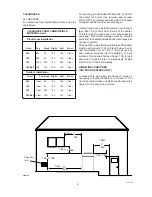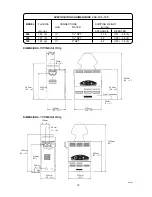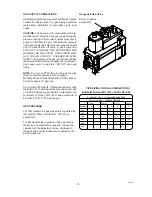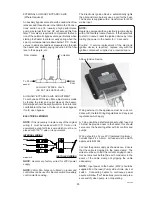
27-01-04
6
3.
Make visual check of the burner and pilot
flame. Flame pattern on the main burner and pilot
is indicated in the previous illustration. Yellow
flame means restriction of the air openings. Lifting
or blowing flame indicates high gas pressure. Low
flame means low gas pressure. Should this occur,
shut the heater off and contact your gas supplier
or qualified service agency.
4.
On indoor heaters, clean room intake open-
ings to assure adequate flow of combustion and
ventilation air.
CAUTION:
Combustion air must not be
contaminated by corrosive chemical fumes which
can damage the heater and void the warranty.
5.
Keep area around heater clear and free from
combustible materials, gasoline and other
flammable and corrosive vapours and liquids.
POOL & SPA WATER CHEMISTRY
IMPORTANT!
These Heaters are not suitable for
use on Salt Chlorinated pools. If this is intended
please contact the Manufacturer.
Chemical imbalance can cause severe damage to
your heater and associated equipment. Maintain
your water pH between 7.4 and 7.8 and total
alkalinity between 100 and 150 p.p.m. If the
mineral content and dissolved solids in the water
become too high, scale forms inside the heat
exchanger tubes, reducing heater efficiency and
also damaging the heater. If the pH drops below
7.2, the heater will be severely damaged. This will
result in corrosion of the heat exchanger.
Heat
exchanger damage resulting from chemical
imbalance is not covered by the warranty.
AUTOMATIC CHLORINATORS AND CHEMICAL
FEEDERS
All chemicals must be introduced and completely
diluted into the pool or spa water before being
circulated through the heater. Do not place
chlorine tablets or bromine sticks in the skimmer.
High chemical concentrations will result when the
pump is not running (i.e. overnight).
Chlorinators must feed downstream of the heater
and have an anti-siphoning device to prevent
chemical back-up into the heater when the pump is
shut off.
NOTE:
High chemical concentrates from feeders
and chlorinators that are out of adjustment will
cause very rapid corrosion to the heat exchanger in
the heaters. Such damage is not covered under the
warranty.
COLD WEATHER OPERATION
MODERATE CLIMATE:
Heater operation can con-
tinue during short term cold spells. When tempera-
tures are below freezing, flow (continuous pump
operation) must be maintained.
CAUTION
: Do not use the heater to maintain water
temperatures just above freezing or for freeze pro-
tection. When heater is used during freezing
weather, care must be taken to avoid freeze ups.
Continuous pump operation is a must. Additional
protection may be required. The heater is not
warranted against freeze ups.
COLD CLIMATE:
Prolonged operation with water
temperatures below 10°C (50°F) is not
recommended. When starting the heater with pool
temperatures below 10°C (50°F) operate the heater
continuously until higher temperatures are reached.
Operating the heater for prolonged periods with pool
water below 10°C (50°F) can seriously damage the
heater, and is not covered by the warranty.
For cold climate areas, please follow the winterizing
procedures listed.
WINTERIZING THE POOL & SPA HEATER
When heaters installed outdoors in freezing climate
areas are to be shut down for the winter, observe the
following step-by-step procedure:
1.
Turn off gas valve, manual gas valve, and
electrical supply to the heater.
2.
Open drain cock located on the inlet/outlet
header, (under water pipes). Remove drain
plug from return header. Remove the heat
exchanger inspection panels on the side op-
posite water piping to gain access to the
plug on the return header.
Return Header
3.
Disconnect compression fittings from the
pressure switch and return header that con-
nects to the 1/4" copper tube and allow the
tube to drain.
plug.tif
Drain
Plug









































